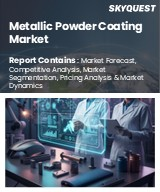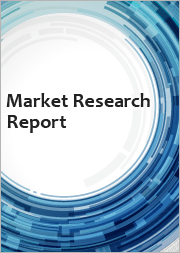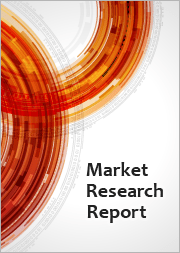
|
시장보고서
상품코드
1679622
항균 유리 파우더 시장 규모, 점유율, 동향 분석 보고서(2025-2030년) : 제품별, 용도별, 최종 용도별, 지역별, 부문별 예측Antimicrobial Glass Powder Market Size, Share & Trends Analysis Report By Product (Copper, Silver, Zinc), By Application (Paints & Coatings), By End-use, By Region, And Segment Forecasts, 2025 - 2030 |
||||||
항균 유리 파우더 시장의 성장과 동향
Grand View Research, Inc.의 최신 보고서에 따르면 세계 항균 유리 파우더 시장 규모는 2030년까지 46억 9,000만 달러에 달할 것으로 예측되고, 2025-2030년의 CAGR은 7.5%를 나타낼 것으로 예측됩니다. 항균 유리 파우더 산업은 위생 및 건강 지향 제품에 대한 수요 증가와 같은 몇 가지 주요 요인에 의해 큰 성장을 이루고 있습니다. 박테리아, 바이러스 및 기타 병원체의 확산에 대한 우려가 높아지는 가운데 의료, 식품 포장, 건설 등의 산업은 청결을 유지하고 오염을 방지하는 혁신적인 솔루션을 찾고 있습니다. 항균 유리 파우더는 벽, 창문 및 기타 표면 코팅을 포함한 다양한 용도에 사용되며 유해한 미생물로부터 내부를 보호합니다.
원내 감염 증가나 COVID-19와 같은 바이러스성 질환의 세계적인 영향으로 감염증의 전염 방지가 중요시되고 있습니다. 그 결과 항균 유리 파우더는 청결이 최우선인 의료 환경에서 사용되는 제품에 통합됩니다. 공공장소와 사적 공간에서의 안전과 위생에 대한 관심 증가는 병원체로부터 지속적으로 보호하는 항균 물질에 대한 수요를 높이고 있습니다.
스마트하고 지속 가능하며 건강을 고려한 아키텍처의 동향이 높아짐에 따라 항균 코팅은 건축자재의 내구성과 안전성을 높이는 데 사용됩니다. 항균 특성을 지닌 유리 파우더는 사람들이 많은 곳에서 특히 유용하며 표면에 박테리아와 곰팡이가 발생하는 것을 방지하여 전반적인 공기 품질을 향상시키고 유지 보수의 필요성을 줄입니다. 또한, 항균 유리 파우더를 외면에 사용하면 조류와 곰팡이의 번식을 억제하고 건물의 수명을 연장하여 빈번한 청소와 교체의 필요성을 줄일 수 있습니다.
스마트폰, 전자기기, 주방용품, 가정용 장식품 등 생활용품에 대한 위생이 높은 관심을 얻고 있는 가운데, 항균 유리 파우더는 소비자와 직접 접촉하는 코팅이나 재료에 도입되고 있습니다. 일상 생활에서 사용되는 제품을 박테리아로부터 보호할 수 있다는 점은 혼잡한 시장에서 제조업체에게 경쟁을 가져옵니다. 이 추세는 소비자가 매일 건강과 청결을 우선시하는 유행 후의 시대에 특히 중요합니다.
항균 유리 파우더 시장 보고서 하이라이트
- 은 부문은 2024년에 43.4%의 가장 큰 수익 점유율로 시장을 선도했으며, 탁월한 항균 특성과 박테리아 성장을 막는 높은 효과를 보였습니다.
- 용도별로는 페인트 및 코팅 부문이 2024년에 40.2%의 최대 수익 점유율로 시장을 선도하고 있습니다.
- 최종 용도별로는 식품 및 의료 부문에서 항균 포장 솔루션 수요 증가로 인해 포장 부문이 예측 기간 동안 가장 높은 CAGR 8.7%를 나타낼 것으로 예측됩니다. 이 성장의 원동력은 보존 기간의 연장과 제품의 안전 강화에 대한 요구 증가입니다.
- 아시아태평양은 급속한 산업화, 의료 인프라 성장, 그리고 소비재 및 건축자재의 항균 솔루션 수요 증가로 2024년 31%의 최대 수익 점유율로 시장을 독점하고 있습니다.
목차
제1장 조사 방법과 범위
제2장 주요 요약
제3장 시장의 변수, 동향, 범위
- 세계의 항균 유리 파우더 시장 전망
- 산업 밸류체인 분석
- 유통 채널 분석
- 기술 개요
- 규제 프레임워크
- 시장 역학
- 시장 성장 촉진요인 분석
- 시장 성장 억제요인 분석
- 시장 기회 분석
- 시장의 과제
- Porter's Five Forces 분석
- 공급자의 협상력
- 구매자의 협상력
- 대체 위협
- 신규 참가업체의 위협
- 경쟁 기업간 경쟁 관계
- PESTLE 분석
- 정치
- 경제
- 사회
- 기술
- 환경
- 법률
제4장 항균 유리 파우더 시장 : 제품별, 추정 및 동향 분석
- 항균 유리 파우더 시장 : 제품 변동 분석(2024년 및 2030년)
- 구리
- 은
- 아연
- 기타
제5장 항균 유리 파우더 시장 : 용도별, 추정 및 동향 분석
- 항균 유리 파우더 시장 : 용도 변동 분석(2024년 및 2030년)
- 페인트 및 코팅
- 플라스틱 및 폴리머
- 섬유 및 직물
- 기타
제6장 항균 유리 파우더 시장 : 최종 용도별, 추정 및 동향 분석
- 항균 유리 파우더 시장 : 최종 용도 변동 분석(2024년 및 2030년)
- 의료
- 소비자용 전자기기
- 포장
- 건축 및 건설
- 기타
제7장 항균 유리 파우더 시장 : 지역별, 추정 및 동향 분석
- 지역 분석(2024년 및 2030년)
- 북미
- 제품별(2018-2030년)
- 용도별(2018-2030년)
- 최종 용도별(2018-2030년)
- 미국
- 캐나다
- 멕시코
- 유럽
- 제품별(2018-2030년)
- 용도별(2018-2030년)
- 최종 용도별(2018-2030년)
- 독일
- 영국
- 이탈리아
- 스페인
- 프랑스
- 아시아태평양
- 제품별(2018-2030년)
- 용도별(2018-2030년)
- 최종 용도별(2018-2030년)
- 중국
- 인도
- 일본
- 한국
- 중남미
- 제품별(2018-2030년)
- 용도별(2018-2030년)
- 최종 용도별(2018-2030년)
- 브라질
- 중동 및 아프리카
- 제품별(2018-2030년)
- 용도별(2018-2030년)
- 최종 용도별(2018-2030년)
- 사우디아라비아
- 아랍에미리트(UAE)
제8장 경쟁 구도
- 주요 시장 진출기업에 의한 최근 동향과 영향 분석
- 기업 분류
- 히트맵 분석
- 벤더 상황
- 판매점 일람
- 잠재적 최종 사용자 목록
- 전략 이니셔티브
- 기업 프로파일/상장 기업
- JIANGSU SUNCHEM
- Wienerberger AG
- Interglass
- SaintGobain
- Corning
- Pittsburgh Glass Works
- Asahi Glass Co
- Borosil Glass Works
- AGC Inc
- Kibbutz Sha'ar HaGolan
- Owens Corning
- Vetreria Etrusca
- Guardian Glass
- Nippon Electric Glass
- Schott AG
Antimicrobial Glass Powder Market Growth & Trends:
The global antimicrobial glass powder market size is anticipated to reach USD 4.69 billion by 2030 and is projected to grow at a CAGR of 7.5% from 2025 to 2030, according to a new report by Grand View Research, Inc. The antimicrobial glass powder industry is experiencing significant growth due to several key drivers, including the increasing demand for hygiene and health-conscious products. With rising concerns over spreading bacteria, viruses, and other pathogens, industries like healthcare, food packaging, and construction seek innovative solutions to maintain cleanliness and prevent contamination. Antimicrobial glass powder is used in various applications, including coatings for walls, windows, and other surfaces, offering built-in protection against harmful microbes.
The growing prevalence of hospital-acquired infections and the global impact of viral diseases such as COVID-19 have heightened the focus on preventing the transmission of infectious agents. As a result, antimicrobial glass powder is being incorporated into products used in medical and healthcare environments, where cleanliness is paramount. This growing concern for safety and sanitation in public and private spaces boosts the demand for antimicrobial materials that offer continuous protection against pathogens.
As the trend toward smart, sustainable, and health-conscious buildings increases, antimicrobial coatings are being used to enhance the durability and safety of architectural materials. Glass powders with antimicrobial properties are particularly useful in high-traffic areas, as they prevent the buildup of bacteria and mold on surfaces, improving the overall air quality and reducing maintenance needs. In addition, using antimicrobial glass powder on exterior surfaces helps reduce the growth of algae and fungi, promoting the longevity of buildings and reducing the need for frequent cleaning or replacements.
With growing concerns about hygiene in everyday products like smartphones, electronics, kitchenware, and home decor, antimicrobial glass powder is being incorporated into coatings and materials that come into direct contact with consumers. The ability to offer enhanced protection against germs and bacteria in everyday products provides a competitive edge for manufacturers in a crowded market. This trend is especially important in the post-pandemic era, as consumers prioritize health and cleanliness daily.
Antimicrobial Glass Powder Market Report Highlights:
- The silver segment led the market with the largest revenue share of 43.4% in 2024, due to its superior antimicrobial properties and high effectiveness in preventing bacterial growth.
- Based on application, the paints & coatings segment led the market with the largest revenue market share of 40.2% in 2024, driven by the growing demand for antimicrobial protection in architectural and industrial applications.
- Based on end use, the packaging segment is anticipated to register at the fastest CAGR of 8.7% over the forecast period, due to the rising demand for antimicrobial packaging solutions in the food and healthcare sectors. This growth is driven by the increasing need for longer shelf life and enhanced product safety.
- Asia Pacific dominated the market with the largest revenue share of 31% in 2024, due to rapid industrialization, growing healthcare infrastructure, and rising demand for antimicrobial solutions in consumer goods and building materials.
Table of Contents
Chapter 1. Methodology and Scope
- 1.1. Market Segmentation & Scope
- 1.2. Market Definition
- 1.3. Information Procurement
- 1.3.1. Information Analysis
- 1.3.2. Data Analysis Models
- 1.3.3. Market Formulation & Data Visualization
- 1.3.4. Data Validation & Publishing
- 1.4. Research Scope and Assumptions
- 1.4.1. List of Data Sources
Chapter 2. Executive Summary
- 2.1. Market Outlook
- 2.2. Segmental Outlook
- 2.3. Competitive Outlook
Chapter 3. Market Variables, Trends, and Scope
- 3.1. Global Antimicrobial Glass Powder Market Outlook
- 3.2. Industry Value Chain Analysis
- 3.2.1. Sales Channel Analysis
- 3.3. Technology Overview
- 3.4. Regulatory Framework
- 3.5. Market Dynamics
- 3.5.1. Market Driver Analysis
- 3.5.2. Market Restraint Analysis
- 3.5.3. Market Opportunity Analysis
- 3.5.4. Market Challenges
- 3.6. Porter's Five Forces Analysis
- 3.6.1. Bargaining Power of Suppliers
- 3.6.2. Bargaining Power of Buyers
- 3.6.3. Threat of Substitution
- 3.6.4. Threat of New Entrants
- 3.6.5. Competitive Rivalry
- 3.7. PESTLE Analysis
- 3.7.1. Political
- 3.7.2. Economic
- 3.7.3. Social Landscape
- 3.7.4. Technology
- 3.7.5. Environmental
- 3.7.6. Legal
Chapter 4. Antimicrobial Glass Powder Market: Product Estimates & Trend Analysis
- 4.1. Antimicrobial Glass Powder Market: Product Movement Analysis, 2024 & 2030
- 4.2. Copper
- 4.2.1. Market estimates and forecasts, 2018 - 2030 (USD Million)
- 4.3. Silver
- 4.3.1. Market estimates and forecasts, 2018 - 2030 (USD Million)
- 4.4. Zinc
- 4.4.1. Market estimates and forecasts, 2018 - 2030 (USD Million)
- 4.5. Others
- 4.5.1. Market estimates and forecasts, 2018 - 2030 (USD Million)
Chapter 5. Antimicrobial Glass Powder Market: Application Estimates & Trend Analysis
- 5.1. Antimicrobial Glass Powder Market: Application Movement Analysis, 2024 & 2030
- 5.2. Paints & Coatings
- 5.2.1. Market estimates and forecasts, 2018 - 2030 (USD Million)
- 5.3. Plastics & Polymers
- 5.3.1. Market estimates and forecasts, 2018 - 2030 (USD Million)
- 5.4. Fiber & Textiles
- 5.4.1. Market estimates and forecasts, 2018 - 2030 (USD Million)
- 5.5. Others
- 5.5.1. Market estimates and forecasts, 2018 - 2030 (USD Million)
Chapter 6. Antimicrobial Glass Powder Market: End Use Estimates & Trend Analysis
- 6.1. Antimicrobial Glass Powder Market: End Use Movement Analysis, 2024 & 2030
- 6.2. Healthcare
- 6.2.1. Market estimates and forecasts, 2018 - 2030 (USD Million)
- 6.3. Consumer Electronics
- 6.3.1. Market estimates and forecasts, 2018 - 2030 (USD Million)
- 6.4. Packaging
- 6.4.1. Market estimates and forecasts, 2018 - 2030 (USD Million)
- 6.5. Building & Construction
- 6.5.1. Market estimates and forecasts, 2018 - 2030 (USD Million)
- 6.6. Others
- 6.6.1. Market estimates and forecasts, 2018 - 2030 (USD Million)
Chapter 7. Antimicrobial Glass Powder Market: Regional Estimates & Trend Analysis
- 7.1. Regional Analysis, 2024 & 2030
- 7.2. North America
- 7.2.1. Market estimates and forecasts, 2018 - 2030 (USD Million)
- 7.2.2. Market estimates and forecasts, by product, 2018 - 2030 (USD Million)
- 7.2.3. Market estimates and forecasts, by application, 2018 - 2030 (USD Million)
- 7.2.4. Market estimates and forecasts, by end use, 2018 - 2030 (USD Million)
- 7.2.5. U.S.
- 7.2.5.1. Market estimates and forecasts, 2018 - 2030 (USD Million)
- 7.2.5.2. Market estimates and forecasts, by product, 2018 - 2030 (USD Million)
- 7.2.5.3. Market estimates and forecasts, by application, 2018 - 2030 (USD Million)
- 7.2.5.4. Market estimates and forecasts, by end use, 2018 - 2030 (USD Million)
- 7.2.6. Canada
- 7.2.6.1. Market estimates and forecasts, 2018 - 2030 (USD Million)
- 7.2.6.2. Market estimates and forecasts, by product, 2018 - 2030 (USD Million)
- 7.2.6.3. Market estimates and forecasts, by application, 2018 - 2030 (USD Million)
- 7.2.6.4. Market estimates and forecasts, by end use, 2018 - 2030 (USD Million)
- 7.2.7. Mexico
- 7.2.7.1. Market estimates and forecasts, 2018 - 2030 (USD Million)
- 7.2.7.2. Market estimates and forecasts, by product, 2018 - 2030 (USD Million)
- 7.2.7.3. Market estimates and forecasts, by application, 2018 - 2030 (USD Million)
- 7.2.7.4. Market estimates and forecasts, by end use, 2018 - 2030 (USD Million)
- 7.3. Europe
- 7.3.1. Market estimates and forecasts, 2018 - 2030 (USD Million)
- 7.3.2. Market estimates and forecasts, by product, 2018 - 2030 (USD Million)
- 7.3.3. Market estimates and forecasts, by application, 2018 - 2030 (USD Million)
- 7.3.4. Market estimates and forecasts, by end use, 2018 - 2030 (USD Million)
- 7.3.5. Germany
- 7.3.5.1. Market estimates and forecasts, 2018 - 2030 (USD Million)
- 7.3.5.2. Market estimates and forecasts, by product, 2018 - 2030 (USD Million)
- 7.3.5.3. Market estimates and forecasts, by application, 2018 - 2030 (USD Million)
- 7.3.5.4. Market estimates and forecasts, by end use, 2018 - 2030 (USD Million)
- 7.3.6. UK
- 7.3.6.1. Market estimates and forecasts, 2018 - 2030 (USD Million)
- 7.3.6.2. Market estimates and forecasts, by product, 2018 - 2030 (USD Million)
- 7.3.6.3. Market estimates and forecasts, by application, 2018 - 2030 (USD Million)
- 7.3.6.4. Market estimates and forecasts, by end use, 2018 - 2030 (USD Million)
- 7.3.7. Italy
- 7.3.7.1. Market estimates and forecasts, 2018 - 2030 (USD Million)
- 7.3.7.2. Market estimates and forecasts, by product, 2018 - 2030 (USD Million)
- 7.3.7.3. Market estimates and forecasts, by application, 2018 - 2030 (USD Million)
- 7.3.7.4. Market estimates and forecasts, by end use, 2018 - 2030 (USD Million)
- 7.3.8. Spain
- 7.3.8.1. Market estimates and forecasts, 2018 - 2030 (USD Million)
- 7.3.8.2. Market estimates and forecasts, by product, 2018 - 2030 (USD Million)
- 7.3.8.3. Market estimates and forecasts, by application, 2018 - 2030 (USD Million)
- 7.3.8.4. Market estimates and forecasts, by end use, 2018 - 2030 (USD Million)
- 7.3.9. France
- 7.3.9.1. Market estimates and forecasts, 2018 - 2030 (USD Million)
- 7.3.9.2. Market estimates and forecasts, by product, 2018 - 2030 (USD Million)
- 7.3.9.3. Market estimates and forecasts, by application, 2018 - 2030 (USD Million)
- 7.3.9.4. Market estimates and forecasts, by end use, 2018 - 2030 (USD Million)
- 7.4. Asia Pacific
- 7.4.1. Market estimates and forecasts, 2018 - 2030 (USD Million)
- 7.4.2. Market estimates and forecasts, by product, 2018 - 2030 (USD Million)
- 7.4.3. Market estimates and forecasts, by application, 2018 - 2030 (USD Million)
- 7.4.4. Market estimates and forecasts, by end use, 2018 - 2030 (USD Million)
- 7.4.5. China
- 7.4.5.1. Market estimates and forecasts, by product, 2018 - 2030 (USD Million)
- 7.4.5.2. Market estimates and forecasts, by application, 2018 - 2030 (USD Million)
- 7.4.5.3. Market estimates and forecasts, by end use, 2018 - 2030 (USD Million)
- 7.4.6. India
- 7.4.6.1. Market estimates and forecasts, by product, 2018 - 2030 (USD Million)
- 7.4.6.2. Market estimates and forecasts, by application, 2018 - 2030 (USD Million)
- 7.4.6.3. Market estimates and forecasts, by end use, 2018 - 2030 (USD Million)
- 7.4.7. Japan
- 7.4.7.1. Market estimates and forecasts, by product, 2018 - 2030 (USD Million)
- 7.4.7.2. Market estimates and forecasts, by application, 2018 - 2030 (USD Million)
- 7.4.7.3. Market estimates and forecasts, by end use, 2018 - 2030 (USD Million)
- 7.4.8. South Korea
- 7.4.8.1. Market estimates and forecasts, by product, 2018 - 2030 (USD Million)
- 7.4.8.2. Market estimates and forecasts, by application, 2018 - 2030 (USD Million)
- 7.4.8.3. Market estimates and forecasts, by end use, 2018 - 2030 (USD Million)
- 7.5. Central & South America
- 7.5.1. Market estimates and forecasts, 2018 - 2030 (USD Million)
- 7.5.2. Market estimates and forecasts, by product, 2018 - 2030 (USD Million)
- 7.5.3. Market estimates and forecasts, by application, 2018 - 2030 (USD Million)
- 7.5.4. Market estimates and forecasts, by end use, 2018 - 2030 (USD Million)
- 7.5.5. Brazil
- 7.5.5.1. Market estimates and forecasts, by product, 2018 - 2030 (USD Million)
- 7.5.5.2. Market estimates and forecasts, by application, 2018 - 2030 (USD Million)
- 7.5.5.3. Market estimates and forecasts, by end use, 2018 - 2030 (USD Million)
- 7.6. Middle East & Africa
- 7.6.1. Market estimates and forecasts, 2018 - 2030 (USD Million)
- 7.6.2. Market estimates and forecasts, by product, 2018 - 2030 (USD Million)
- 7.6.3. Market estimates and forecasts, by application, 2018 - 2030 (USD Million)
- 7.6.4. Market estimates and forecasts, by end use, 2018 - 2030 (USD Million)
- 7.6.5. Saudi Arabia
- 7.6.5.1. Market estimates and forecasts, by product, 2018 - 2030 (USD Million)
- 7.6.5.2. Market estimates and forecasts, by application, 2018 - 2030 (USD Million)
- 7.6.5.3. Market estimates and forecasts, by end use, 2018 - 2030 (USD Million)
- 7.6.6. UAE
- 7.6.6.1. Market estimates and forecasts, 2018 - 2030 (USD Million)
- 7.6.6.2. Market estimates and forecasts, by product, 2018 - 2030 (USD Million)
- 7.6.6.3. Market estimates and forecasts, by application, 2018 - 2030 (USD Million)
- 7.6.6.4. Market estimates and forecasts, by end use, 2018 - 2030 (USD Million)
Chapter 8. Competitive Landscape
- 8.1. Recent Developments & Impact Analysis, By Key Market Participants
- 8.2. Company Categorization
- 8.3. Heat Map Analysis
- 8.4. Vendor Landscape
- 8.4.1. List of distributors
- 8.5. List of prospective end-users
- 8.6. Strategy Initiatives
- 8.7. Company Profiles/Listing
- 8.7.1. JIANGSU SUNCHEM
- 8.7.1.1. Company Overview
- 8.7.1.2. Financial Performance
- 8.7.1.3. Product Benchmarking
- 8.7.2. Wienerberger AG
- 8.7.2.1. Company Overview
- 8.7.2.2. Financial Performance
- 8.7.2.3. Product Benchmarking
- 8.7.3. Interglass
- 8.7.3.1. Company Overview
- 8.7.3.2. Financial Performance
- 8.7.3.3. Product Benchmarking
- 8.7.4. SaintGobain
- 8.7.4.1. Company Overview
- 8.7.4.2. Financial Performance
- 8.7.4.3. Product Benchmarking
- 8.7.5. Corning
- 8.7.5.1. Company Overview
- 8.7.5.2. Financial Performance
- 8.7.5.3. Product Benchmarking
- 8.7.6. Pittsburgh Glass Works
- 8.7.6.1. Company Overview
- 8.7.6.2. Financial Performance
- 8.7.6.3. Product Benchmarking
- 8.7.7. Asahi Glass Co
- 8.7.7.1. Company Overview
- 8.7.7.2. Financial Performance
- 8.7.7.3. Product Benchmarking
- 8.7.8. Borosil Glass Works
- 8.7.8.1. Company Overview
- 8.7.8.2. Financial Performance
- 8.7.8.3. Product Benchmarking
- 8.7.9. AGC Inc
- 8.7.9.1. Company Overview
- 8.7.9.2. Financial Performance
- 8.7.9.3. Product Benchmarking
- 8.7.10. Kibbutz Sha'ar HaGolan
- 8.7.10.1. Company Overview
- 8.7.10.2. Financial Performance
- 8.7.10.3. Product Benchmarking
- 8.7.11. Owens Corning
- 8.7.11.1. Company Overview
- 8.7.11.2. Financial Performance
- 8.7.11.3. Product Benchmarking
- 8.7.12. Vetreria Etrusca
- 8.7.12.1. Company Overview
- 8.7.12.2. Financial Performance
- 8.7.12.3. Product Benchmarking
- 8.7.13. Guardian Glass
- 8.7.13.1. Company Overview
- 8.7.13.2. Financial Performance
- 8.7.13.3. Product Benchmarking
- 8.7.14. Nippon Electric Glass
- 8.7.14.1. Company Overview
- 8.7.14.2. Financial Performance
- 8.7.14.3. Product Benchmarking
- 8.7.15. Schott AG
- 8.7.15.1. Company Overview
- 8.7.15.2. Financial Performance
- 8.7.15.3. Product Benchmarking
- 8.7.1. JIANGSU SUNCHEM
(주말 및 공휴일 제외)


















